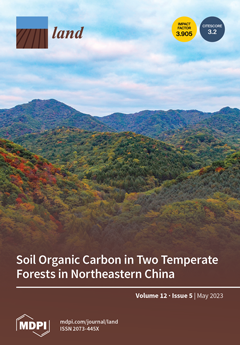The low nitrogen content of Bangka Island’s post-tin-mining soil may limit its suitability for agricultural production. In this study, we investigated the effect of locally available organic soil amendments on nitrogen fixation (N
2–fixation) and crop nitrogen (N) uptake in a cassava–legume
[...] Read more.
The low nitrogen content of Bangka Island’s post-tin-mining soil may limit its suitability for agricultural production. In this study, we investigated the effect of locally available organic soil amendments on nitrogen fixation (N
2–fixation) and crop nitrogen (N) uptake in a cassava–legume intercrop system. Cassava was intercropped with centrosema in post-tin-mining soils with six treatments, including a control and different soil amendments, such as dolomite, compost, charcoal, a combined treatment of charcoal and compost, and a combined treatment of compost and sawdust. The percentages of N derived from N
2-fixation (%Ndfa) with the different seasons and treatments were comparable. Nonetheless, due to the higher shoot biomass accumulation, the mass of N
2–fixation in soil amended with compost and when combined with charcoal was significantly higher than the control (50 to 73 kg ha
−1). Treatments with compost and its combination with charcoal exhibited higher N uptake from the cassava–centrosema intercropped system (82 and 137 kg ha
−1) and higher inorganic ammonium (NH
4+) concentrations in the soil at harvest time (5.5 and 6.7 µg g
−1). When combined with organic soil amendments, N
2–fixation from centrosema produces not only higher biomass, but also higher N contribution to the system. Overall, locally available organic amendments, particularly the combined application of charcoal and compost, showed promise for improving N
2–fixation of intercrop centrosema as well as for increasing N availability in the soil, which is of critical importance for crop growth in post-mining soils that have lost fertility.
Full article





